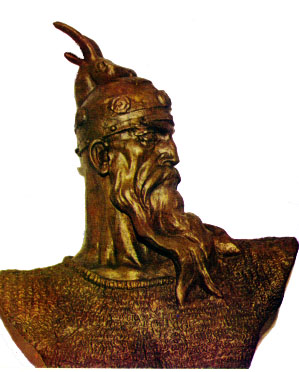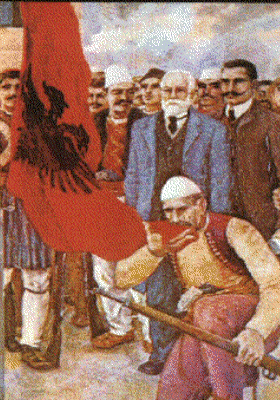

|
|
|
The word Çam is an evolution of the word "t'chiam" which is the name of an ancient river passing right through Çameria(The word T'chamis appears on many ancient Roman and even Hellenic maps, indicating that the word Chameria is older than the word Epirus, and it's used only by us Albanians). Another branch of this river remains to be known to this day as the "lumi i kalamait"( Kalamait River). What's most important is that everything about Çameria is Albanian in every sense of the word. The word Çameria has more of a topological meaning, but Çams have a very strong Albanian ethnicity, tradition and customs. Çameria has a very welldefined ethno-geographical meaning, which is strongly Albanian. A large number of Çam population is situated on the seaside and goes up to the Gulf of Preveza. Another considerable number of towns and villages are situated on both sides of the river of "kalamait". The rest of of the Çam villages and towns are situated in more remote places and often on hills and mountains.. The greek goverment has been very hostile toward Çams and the main reason is the fact that Çams have a very strong Albanian identity. Another reason of the Greek hostilities is the fact that Greeks inhereted a very hostile policy towards us. During the period of time, from 1854 till 1877 the Albanians of Çameria resisted successfully the attacks from Greek "Andartes". During the WWI and WWII the greek troops attacked Çameria again. The (provisional) government of Vlora (Albania) responded by sending Albanian military troops to assist the Albanian population of Çameria , but the decision of the Ambassadors Conference assigned Çameria to Greece. As a result of this decision by the great powers, Greeks forces led by the hateful figure of N. Zervas launched attackes that ended up with many innocent Albanian locals killed. To this day, we Çams in greece are described as bad people from an increasing "safocating" Greek propaganda based on the fact that we refuse to be assimilated as it is the case with some of "Arvanites" in south and central Greece. The today exact number of Albanians of Çameria in Greece is approx. one million people, taking into the account some relativly newly formed Çam villages and towns elsewhere in Greece..if all the number of Albanians in Çameria is added to the number of Arvanites in other areas of Greece, then the total number of Albanians in Greece is around 3.000.000 people. However only Albanians in Çameria call themselves real Shqiptars(Albanians). Arvanites elsewhere in Greece are under greater assimilating preasure from the Greek goverment and Ani-Albanian greek circles.
|
However both Albanian relegious communities were extrimily close to each-other before the war and to this day, the Greek goverment has not managed to assimilate the Albanians of Çameria. The Albanian language is spoken indoors and outdoors as much as on everyday working places, but the greek govemnet with very little preasure from outside refuses to recognise Albanian minority in greece and refuses to open schools on Albanian language. The region is officially known asEpirus by the Greek goverment, but on the further north western corner of Greece, every single people knows the place as Çameria. Anyone from this region stating that he or she is a Çam, makes a political statment saying that he or she is an Albanian. That's why the greek goverment doesn't know officially the region as Çameria.The heartland of Çameria is also called Thesprotia. Since i am from Çameria, my own opinion is that this region has still an Albanian majority(since many people of other ethnic groups have emigrated away, which has compensated somehow for the displacment of some Albanians during wwi and wwii!) and all the Çams expelled unjustifiably from Greece are very welcomed by all the Albanian people here, there is a UN resolution which asks the Greek govement to repatriate our brothers and sisters back to their homes, where they belog among the rest of us. |
During the summer of 1944, the neo-nazi forces led by Zervas attacked many villages and towns of Chameria and as a result 9,000 Albanians(including children, women and old folks) were killed indiscriminately. A considerable number of Albanians were expelled and live now in the Republic of Albania.The official number of those Albanian refugees from Chameria is between 150,000 and 300,000.
Today they have formed their own Albanian patriotic and cultural association based in Tirana and which is active right across Albania. Among other they are asking from the Greek goverment in Athens-Greece, to be repatriated and their lands and other accets be returned to them as well as compasations for the usage of the lands for the past 50 years.
Also they are rallying for the opening of Albanian schools to the Albanians living in Chameria.
The policy of expulsion of Cham Albanians from Chameria had started earlier than 1944. Greeks as well as Serbs followed the same pattern in politics with respect to Albanians. Often they had signed documents with the Turkish government for the exchange of Moslims with Christians. During all this not a single Cham Albanian was asked!. As a result of such policy around 850,000 Cham Albanians from Chameria were sent to Turkey, where they are settled in the region of asia minor in Turkey.
|
Faik Bey Konitza(1875-1942). A great Albanian patriot, born in Konitza in the Pindus Mountains in northern Greece.
Hasan Tahsini,a great Albanian Scholar, born in Chameria, founder of the first University in Istambul-Turkey.
Francesco Solano, born in 1914 in Calabria. He was a great Arberesh Scholar of Albanian Cham roots.
In 1877, Abdyl Frasheri set up a secret Albanian Comittee in Janina(Joannina)-north western Greece, where he had been educated.
Kosova: A short History by Neal Malcolm The Illyrians by John Wilkes The Illyrians, by Stipcevic Arvanites by Irakli KoÇollari The Albanians: An Ethnic History from Prehistoric Times to the Present by Edwin E. Jacques 
Gjergj Kastrioti-Skenderbeg. The great Albanian hero. A great modern time "Skenderbeg" is needed to free all Albanian territories, which are currently under the slavery of the Greeks, Serbs, Macedonians and Montenegrians.

On a very special day in 1912, near our beautiful Flag, united for our united ethnic Albania.. |
|
|
|